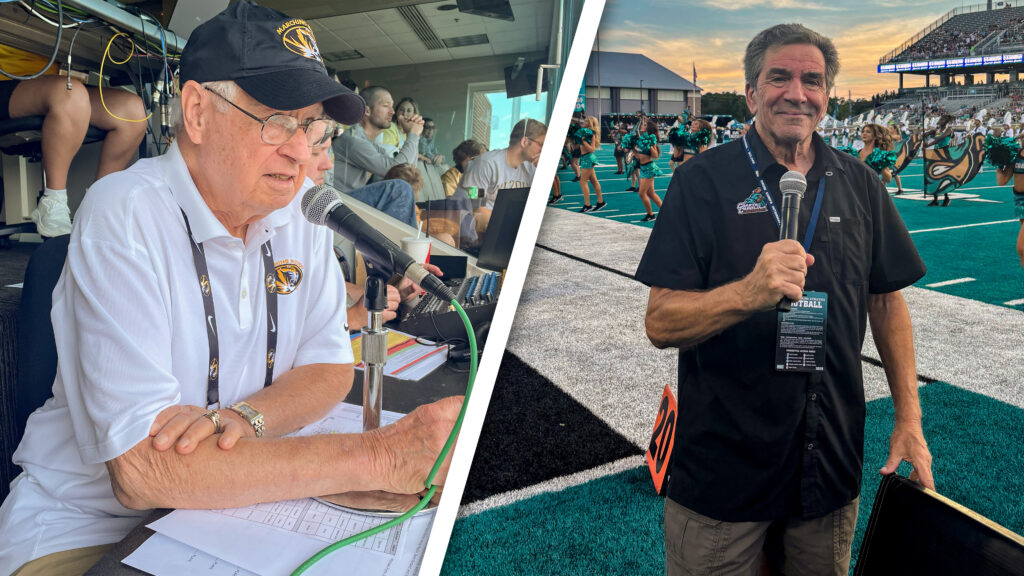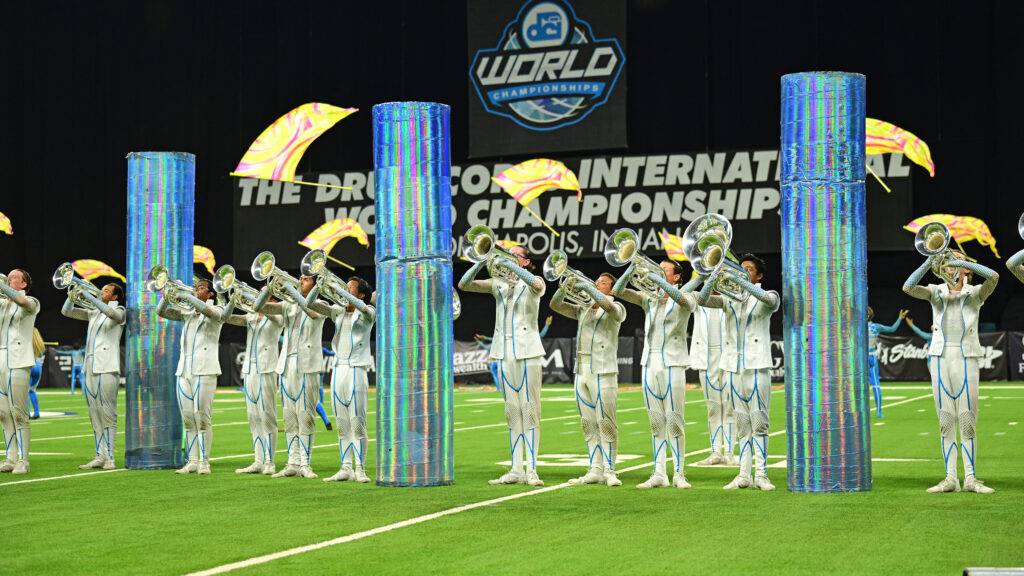
By Michael Boo
Recently, I had a chance to chat with one my favorite people, Dennis DeLucia.
He recounted how Bridgemen became the Bridgemen corps audiences loved and remember. The following are Dennis’ recollections of this very special time in DCI’s early history.
“Perhaps your readers don’t recall that Bobby Hoffman had a drum corps career before signing on with the Bridgemen in 1976. He was a designer/instructor for the Hawthorne Muchachos in the late ’60s, the Garfield Cadets in the early ’70s, the Anaheim Kingsmen around 1972-1974, and the Blue Stars in 1975. He came home to New Jersey to change the face of corps/bands/guards forever by creating the non-militaristic wacky entity known as “Bayonne” in 1976.
“The St. Andrew’s Bridgemen had been founded in the late 1960s, wore white/yellow/black “cadet-style” uniforms and became a DCI finalist in 1972, the very first year of DCI, and again in 1973. They faltered dramatically in 1974 and 1975, falling out of finals both years. Bobby met with Ed Holmes, the founder and director of the corps, in late August of 1975 and agreed to become the program coordinator/drill designer on one condition — that management of the (conservative) corps would not and could not interfere with the artistic journey that he envisioned. Ed agreed, and the rest is history!
“I had been the percussion arranger/instructor for the Muchachos from 1970 through 1975, but had decided to leave after the 1975 season. Bobby asked me to fill the same role, plus work closely with him on the design and implementation of the corps’ show and identity. I immediately said “yes!”
“Bobby’s original thought was to create a Cossack look; long black coats, high black boots and a Cossack-type hat. I asked him if this was to be a one-year uniform. He said, “No. Why?” I replied, “What music do you intend to play in the SECOND year? THIRD? FOURTH?” I felt that the amount of viable corps-friendly music in the Cossack style was limited, and, as we had discovered with the Muchachos, if your uniformed identity is so clearly defined, it becomes very difficult to play music that emanates from outside of that realm. If you LOOK Spanish, can you get away with playing German classical music?
“I knew the owner of a hat manufacturer in New Jersey, and set up an appointment for Bobby and I to visit his factory. During the tour, we encountered a worker who was blocking cowboy hats. Bobby asked her if she could NOT block the sides of the hat UP (to form the typical “cowboy” look), but could she block the front and back of the brim DOWN. She could, and did. And so the “BRIDGEMEN” hat was born! That moment, which I remember so vividly, was the moment that “The BAYONNE Bridgemen” established its identity as urban, hip, different, cocky. That was the day that the corps “attitude” was created — you know, “Strap in, open your eyes, ears and minds. We KNOW you’re going to love us, but we don’t give a damn if you don’t!”
“So, now we had a long coat and a “pimp” hat. Boots? Gone in favor of shoes. Plume? NO WAY! Instead, we had a brightly colored scarf tied around the brim, with an 18-inch piece hanging down the back. Color? Bobby’s vision now switched from black to pastels; each section of the corps would wear the long coat, but the sopranos would wear lime green, the mid-range pale yellow, the low brass pale blue, the drum line light pink and the guard lavender. (I forget which section was going to wear what color, but the concept I’ve outlined is absolutely accurate.)
“This way, if the sopranos had the lead, it would be a “green” moment; the drum solo would be a “pink” moment, etc. So, he had samples made of the coat in four of the colors, and at the end of a Sunday rehearsal he had four members of the corps go into a back room and put them on. He then told the corps about the concept behind the look, the “attitude” and the show. With baited breath he asked the four “models” to come into the room.
“I thought that we would never get out alive! The reaction to the ideas was one of ready acceptance, but those COLORS! Kids threatened to quit and/or run the staff out of town!
“They were from Bayonne, after all, and THEIR corps colors were black, white and yellow. Bobby wisely listened, and the yellow “banana” coats were born, with black and white trim, black shoes, and black pants. The guard would wear the same coat, but it would be black with white and yellow trim.
“Everyone was satisfied and excited about the new look, about being a part of a groundbreaking endeavor, about “going for it!”
“At the end of a very hot, humid rehearsal day in June of 1976, Bobby wanted one more run-through. The corps secretly decided to “faint” at the end of the run. The staff howled! It was never discussed again — that is, until the morning of DCI Finals, when he asked me if I remembered that rehearsal. I said, “Of course!” He asked, “How about we do it tonight, at the end of our finals performance?” I smiled and nodded, he told the corps, we “rehearsed” it twice and went to finals, where we finished in sixth place.
“I doubt if anyone will ever forget that first season: How it all came to pass, how magnificent the crowds were, how much fun we had, how many friends we made, how much love was shared.
“God, I miss them.”
Dennis Calling all readers — Have you ever sponsored a marcher? Why? Are you or have you been a sponsored marcher? How did you do it and how did you thank your sponsors? Please share your stories with us for consideration in a future “Fanfare” column.Send your contribution to Michael Boo at [email protected]. Please put “Sponsored Marcher” in the Subject heading at the top of your e-mail. Please include your name, hometown, corps affiliation (if applicable) and years marching with or working with the corps (if applicable). No anonymous comments, please. We will credit you for your contribution. Michael Boo has been involved with drum and bugle corps since 1975, when he marched his first of three seasons with the Cavaliers. He has a bachelor’s degree in music education and a masters degree in music theory and composition. He has written about the drum corps activity for over a quarter century for publications such as Drum Corps World, and presently is involved in a variety of projects for Drum Corps International, including souvenir program books, CD liner notes, DCI Update and Web articles, and other endeavors.Michael currently writes music for a variety of idioms, is a church handbell and vocal choir director, an assistant director of a community band, and a licensed Realtor in the state of Indiana. His other writing projects are for numerous publications, and he has published an honors-winning book on the history of figure skating.His hobbies include TaeKwonDo and hiking the Indiana Dunes.But more than anything, Michael is proud to love drum corps and to be a part of the activity in some small way, chronicling various facets of each season for the enjoyment of others.





